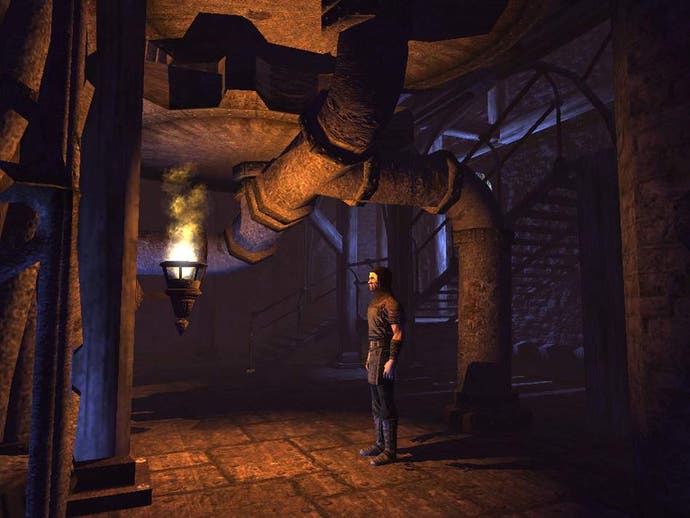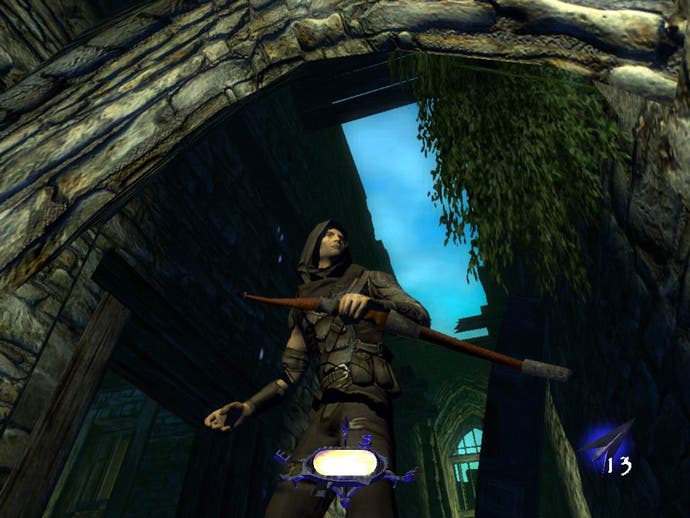Thief: Deadly Shadows
Hank Marvin makes a comeback in new and interesting ways...
Order yours now from Simply Games.
We're all a bit dodgy here at Eurogamer. We've got a Rob and a Nick on the payroll for a start, if that doesn’t offer up enough clues, while Tom's stealthy abilities to filch all the boxed review copies that come into the office have long passed into legend. Appropriate, then, that our most recent staffer, Pat Garratt bears almost the same name as Thief: Deadly Shadows's lead character Garrett, and more than a few similarities in the wardrobe department, legend has it. Some coincidences just can't be resolved. Best to triple lock the front door just in case.
Thief's long overdue arrival on the console scene - in this case the Xbox - could be perceived by long term fans as much of a curse as a blessing. Would Ion Storm be forced to dumb it down in order to appeal to the more casual gamer, or would it stay true to its origins? Offering the game in third person appeared to be the first step towards delivering the kind of game Splinter Cell and Metal Gear Solid fans would appreciate - but would it betray its fan base?
Ambitious accessibility

Any notions that Ion Storm has sold the brand out, however, are quickly dispelled once the first couple of missions are out of the way. If anything, Thief: Deadly Shadows is simultaneously the most ambitious stealth game ever made, while also being perhaps the most genuinely accessible.
As a veteran of both Splinter Cell campaigns and most of the MGS series, it's fair to say that those titles require a degree of patience and resolve that most games would never dare to ask of you. If anything, we were expecting Thief's transition to console to be even more of an exacting exercise in observation and guile - but some cunning design decisions have largely circumvented a large proportion of the frustration inherent in games that demand that you lurk in the shadows and creep around playing hide and seek.
Unlike the resolutely linear experience of, Splinter Cell, Thief offers a far more flexible gameplay experience, often presenting you with several tasks or missions at once. Although the overall direction is still most definitely linear by necessity, there's still a heartening feeling of choice available to you. The game works essentially by placing you within a town and then gradually offering new missions at locations around the town. It's not exactly stealth GTA, but it's most definitely a progression from just hopping from level to level in that you're given a number of other optional things to in between the 'real' missions that often distract you from the main task at hand for hours at a time.
Eavesdrop away

Listening in on conversations can, for example, bring up all new sub mission tasks, while carefully infiltrating all the myriad of nooks and crannies available can often provide explicit clues to booty stashes, not to mention their state of mind. What isn't necessarily obvious at first is the almost subliminal storytelling going on; either in the form of snatches of conversation or the numerous journal entries scattered around that add a layer of depth to what might otherwise feel like your typical hide and sneak.
With the all-new third person mode added, there's even more reason to draw comparisons with the Splinter Cells of this world. At first glance it uses a lot of the same tricks; the thumb stick lock pick system is perhaps the most instantly recognisable comparison, or the delicious use of dynamic lighting, shadow and sound. At its heart the core gameplay admittedly works in almost the same way, but after that you're left reflecting on some very big differences that make you love the game the more you play it. To begin with, you can become obsessed with the light. The first proper mission, for example, makes you shoot out a flaming torch with a Water Arrow, and from then on it became an obsession to black out the levels in the same way as Splinter Cell demands - only a paucity of arrows meant resorting to other tactics became a functional necessity when it became apparent that you rarely have enough cash to justify profligacy.
By shoehorning you into taking other routes to your goal, you soon realise just how many options there are available to you. If you want to sneak, it's very often not just a case of waiting for the right moment, but also taking the right route. It's quite common for you to struggle through to your destination, only to discover there was a far easier and more cunning way to get there that may have entirely avoided any conflict at all. You can, of course, take a more violent approach to your thievery and leave a succession of corpses strewn around the town, and Thief offers a multitude of means if you so wish to play the game this way.
Those deadly penny chews

The most obvious method we came across was to simply whack opponents over the back of the head with a Blackjack, before dumping their limp torsos in darkened corners, but in addition you have a dagger, numerous bombs - notably the Gas bomb, which knocks out a gaggle of foe in one hit, or the Oil bomb, which causes the AI to skid in a slapstick fashion before knocking themselves unconscious. The arrows, however, provide plenty of options to help you gain a sizeable booty stash, with the flaming arrow providing a great incendiary attack near barrels of oil, the water arrow a great dousing ally against the peril of the flaming light, and the moss arrow not only cushioning otherwise noisy floors, but also acting as a means of muffling the cries of would be noisy guards.
One of the best pieces of design in the game is the incentive based gameplay, which positively rewards you in both money and satisfaction. On the default Normal difficulty you'll be tasked with picking up a minimum of 40 per cent of the booty stashed in each level before you can progress - to begin with this can seem like a fairly unwelcome piece of kleptomaniacal design that's forcing you to sniff around levels for the sake of it, but you soon realise that the more treasure you unearth, the more money you can trade it all in for, and therefore the more ammo you can buy in return. It all works out in the end, and the mere fact that you're encouraged to do this means you tend to learn the levels better as a result, meaning a more cunning approach and a better appreciation of how the game is structured.
Learning how to cope with the enemy AI is also a crucial art to learn. Every drone you come across is either having some pre-scripted natter with a pal, or maybe just muttering to themselves - either way, there's a palpable sense that they know what's going on. Perhaps it's fair to say that on Normal level they simple don't chase you far enough, but at least you're not forced to go through the dreaded Game Over sequence for the 200th time as you do with Thief's stealth rivals. Instead, you can always rely on the fact that you can hide out in the dark and wait for them to get bored of looking - as a coherent and less frustrating gameplay experience it's infinitely preferable, if a little amusing when the person looking for you gives up when they're practically on top of you.
Mapped out

In comparison to its peers, the levels are quite sizeable, and often you'll find yourself seriously lost as you try and beat a familiar path without attracting the attentions of your adversaries. One of the major negatives about Thief is its almost useless in-game map, that as well being a pain to access (via two sub menus) also doesn't pinpoint your position, or take into account different floors. It's possibly one of the least helpful in-game maps ever made, and until you've had time to build up your own mental map of each level that you'll be getting lost on a regular basis and singularly unable to make serious progression. It's a time consuming game as it is. You have to pick your way through it carefully, so the last thing you need is something so basic being so inescapably flawed. It's not the end of the world, though, and you quickly accept the fact and just get on with it. In a way it forces you to play the mission in rather the same way as you would in reality- by recognition and common sense rather than a mini map with Sat Nav. This is, after all, a low tech era.
What most definitely cannot be accused of being low tech is the game engine. If anything, such lavish visuals, complemented by a fantastically well implemented persistent state system (i.e. all dead bodies stay right where you left them) are setting the benchmark for what the Xbox can do, both in terms of lighting, texturing, level size, character model detail and animation, and - of course - their rag doll physics. However, such enormous feats of ambition come at a heavy price, with a frame rate well less than the 25fps that Ion Storm would have been gunning for. At times the game feels so sluggish that you'd swear it's struggling to render double figures, but miraculously Ion Storm gets away with it.
It's hard to reconcile how a game that looks so shaky at times can still remain so compelling, but the longer you play it, the less of an issue the low frame rate becomes - however hard that may be to believe. It's a slow paced game anyway, so it's not something that really affect the gameplay from one encounter to the next - chances are you'll be creeping up on your opponent so gently that you'll barely even register the frame rate. There's every chance, however, that PC owners brought up on slick frame rates and high end graphics card will have a fit when they see it in action on an Xbox, but there's one simple solution to that dilemma - buy the PC version.
Honed and dry
As single player experiences go, it's one that will last you an age if you decide to really poke around in all of its dark crevasses, so any moans over the lack of multiplayer mode needn't be a stick to beat Ion Storm with. As much as Thief: Deadly Shadows can feel like quite a hardcore experience, its more open ended structure, combined with the welcome ability to save anywhere makes it a far more accessible product in truth. Its somewhat parochial theme might not be as instantly epic as MGS and it may lack the high tech cool and acrobatics of Splinter Cell, but it makes up for its diminished pyrotechnics by simply being arguably the more absorbing game of any of them.
There's something so pleasingly honed about the overall structure of Deadly Shadows and how that integrates with the gameplay mechanic - and in terms of getting your money's worth, there are few games that suck you in quite as much. Playing for long periods never felt like an obligation - there was rarely a time when we were playing just to see what came next, but more because we wanted to. If it wasn't for the dreadful lack of optimisation we'd be celebrating Thief's arrival on console a whole lot more, but even so, Deadly Shadows is the kind of console game you could have only dreamed of a few years back and it definitely bodes well for the future. For now, it's almost the complete package and warrants your attention.

